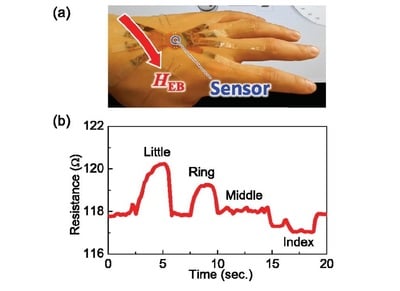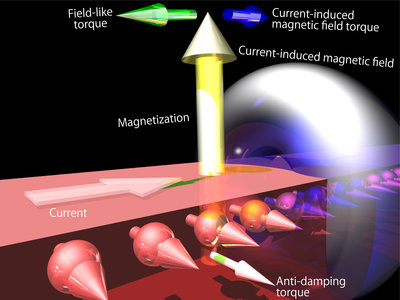The magnetization direction of ferromagnetic materials can be altered by the application of strain owing to the magnetoelastic effect. Using a combination of this effect and the giant magnetoresistive (GMR) or tunnel magnetoresistive (TMR) effect, a strain measurement was experimentally demonstrated. In addition to sensing the strain “magnitude,” we recently achieved strain “direction” sensing using a Co/Cu/NiFe pseudo spin valve (SV) formed on a flexible substrate. This novel function is of advantage to flexible spintronic devices, and the stretchability of both the substrate and thin ferromagnetic layers enables strain sensing on a wide range of arbitrary-shaped surfaces, which is not easy when using devices formed on a rigid semiconductor substrate. These stretchable and miniaturized strain sensors will be of increasing importance for the trillion sensor universe as well as for wearable devices, from the perspective of structural or human health monitoring, body mechanics, and robotics.
In the abovementioned flexible pseudo SV for strain direction sensing, the relative angles between the strain-sensitive Co free layer and the NiFe pinned layer depend on the strain direction, resulting in modulation of the device resistance through the GMR effect. Although NiFe is a strain-insensitive material, the assistance of an external field was required to stably pin its magnetization toward a nominal direction. Because of this external field, the free rotation of the Co layer was hampered; thus, a large strain of more than 1% was needed to identify the strain direction. One approach to solve this problem is using an exchange bias to pin solely the NiFe layer using an antiferromagnetic material. Although there have been several reports on the exchange-biased structure under mechanically or piezoelectrically introduced strain conditions, the robustness and endurance of the exchange bias to the strain applied from various directions, which are key to realizing external-field-free and sensitive functionality, remain controversial.
This letter consists of two main results. The first one concerns the robustness of the exchange bias to the application of strain. Using a NiFe/FeMn bilayer structure formed on a flexible substrate, we confirmed that the exchange bias field and its direction are almost independent of the magnitude and the direction of the mechanically introduced uniaxial tensile strain up to 1.5%. The second result is strain direction sensing using an exchange-biased flexible SV consisting of Co/Cu/NiFe/FeMn layers. In this device, without applying an external field, highly sensitive strain direction sensing is achieved compared to the previous flexible pseudo SV. We also show an experimental demonstration of the identification of the motion of a finger using our exchange-biased flexible SV attached to the back of the hand. In addition to the experiments, theoretical expectations for further improving the sensor performance are discussed.
First, we show the strain dependence of the exchange bias using the NiFe/FeMn bilayer structure. The exchange bias field H EB, its direction, and the magnetic anisotropy of the NiFe layer under various strain conditions were examined from the in-plane magnetic field angle θ H dependence of the device resistance dominated by the anisotropic magnetoresistance (AMR). A 50 μm-thick polyimide film was used as the flexible substrate because it offers resistance to high temperature, which is required in the heating process explained later. The following layer structure was deposited using rf sputtering at room temperature: Ta(2.2)/Pt(2.0)/Cu(4.0)/NiFe(3.0)/FeMn(5.3)/Pt(2.0) from the substrate side. The numbers inside the parentheses indicate the thickness of each layer in nanometers. The layers were defined into a 30 μm-wide wire with two probes for four-terminal measurements using photolithography and Ar-ion milling. To impart the exchange bias, the sample was annealed at 220 °C and cooled to room temperature in vacuum. An in-plane magnetic field of 0.2 T was continually applied along the wire direction during the above heating and cooling processes, i.e., H EB was initially added in the + x direction.

Applied Physics Letters : https://aip.scitation.org/doi/full/10.1063/1.5091033


